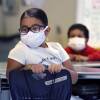COVID-19 has been the central reality of our lives for two years now. But the moment it became real is different for each of us.
For me, it was Wednesday, March 11, 2020. That was the day when Northeastern University, where I teach, announced it was shutting down; when fans were sent home in the midst of an NBA game after a player tested positive; and when then-President Donald Trump delivered a rambling, unnerving address that sent the Dow Jones futures tumbling.
So yes, that’s when we all began to take COVID-19 seriously. But we really had no idea of what was to come. I remember telling my students that I hoped we’d be back in person in a few weeks. Now here we are, two years later, and schools, workplaces, stores and the like are still not fully back to normal, though the situation is certainly far better than it once was.
The arc of our progression from hopefulness to humility can be traced in how Trump and President Joe Biden have spoken about the pandemic. Trump virtually never said an honest word when discussing COVID, telling us over and over during the final months of his presidency that it was no big deal.
Still, a statement he made on Feb. 27, 2020, stands out for its audacious mendacity. “It’s going to disappear,” he said. “One day — it’s like a miracle — it will disappear. And from our shores, we — you know, it could get worse before it gets better. It could maybe go away. We’ll see what happens. Nobody really knows.”
Well, the miracle failed to materialize. By Election Day, nearly 233,000 Americans had died of COVID-19, and we still had nothing to protect ourselves except masks and social distancing.
If Trump’s optimism in the early days of the pandemic proved illusory, there were reasons to be hopeful a year later. Effective vaccines began coming online, and tens of millions of Americans rushed to get the shots. By the Fourth of July, President Joe Biden was cautiously hailing the return to something like normal.
“Don’t get me wrong, COVID-19 has not been vanquished,” he said. “We all know powerful variants have emerged, like the delta variant, but the best defense against these variants is to get vaccinated.” He added: “So, today, while the virus hasn’t been vanquished, we know this: It no longer controls our lives. It no longer paralyzes our nation. And it’s within our power to make sure it never does again.”
We all know what happened next. Delta proved to be far more contagious than the earlier forms of COVID-19. Combined with the maddening, inexplicable refusal among many Americans — disproportionately Trump supporters — to get vaccinated or even wear masks, we experienced a horrifying fall infection rate surge. And then it started to abate.
Until it didn’t.
We were riding home from a Thanksgiving visit with family when I saw a story on my phone about yet another COVID-19 variant, this one out of South Africa. Dubbed omicron, the variant proved to be wildly more contagious than delta, although it seemed to have welcome characteristics as well, such as causing milder illness. Still, omicron ripped through the population, even striking those who had been “triple-vaxxed,” though the rate of severe illness and death among that group was blessedly low.
So here we are again. Two years into the pandemic, we are older, sadder and wiser. The omicron surge has faded as rapidly as it began. But, as I write, some 959,000 Americans have now died of COVID, and the virus seems likely to be with us for years to come. A year ago, we might have exhaled in delight at the prospect of vaccinating our way out of all this. Now we’re just holding our breath.
“We will continue to combat the virus as we do other diseases. And because this is a virus that mutates and spreads, we will stay on guard,” Biden said cautiously in his State of the Union address last week. He added: “I cannot promise a new variant won’t come. But I can promise you we’ll do everything within our power to be ready if it does.”
That’s a long way from saying, as Trump did, that COVID-19 will miraculously “disappear.” It’s also a dialing back of the optimism Biden expressed last summer. But it’s realistic.
Unfortunately, the ongoing stresses caused by COVID-19 come amid other disorienting events. The economy is growing rapidly, but inflation is eating up wage gains. Political strife continues, with a sizable portion of the electorate claiming to believe Trump’s lies that the 2020 election was stolen from him. The planet is still warming.
Looming over all of this is the terrible war being waged by Russia against Ukraine. We feel helpless as increasingly horrific images are beamed onto our televisions and digital devices.
Existence feels fragile. Looking back, it seems as though COVID-19 ushered in a new age of uncertainty. I hope we get through this together.
GBH News contributor Dan Kennedy’s blog, Media Nation, is online at dankennedy.net.








